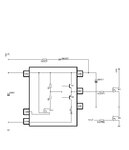SuperTrump
Junior Member level 1
No it's the correct pin! By supplying the driver, before even i turn off the low side so to be able the Cbst to charge, i have 10V and something more on HO.
Follow along with the video below to see how to install our site as a web app on your home screen.
Note: This feature may not be available in some browsers.


Minimum Toff time respectively duty cycle doesn't primarly depend on the capacitor value, because it's a charge balance problem. Of course, you need to keep a minimum capacitance according to the PWM frequency and acceptable voltage drop. Maximum capacitance is more a matter of inrush current and form factors. The selection didn't yet seem particularly critical to me.i just wanted to calculate a bootstrap capacitor value for a minimum Toff time (charging time) for theory and practical reasons!